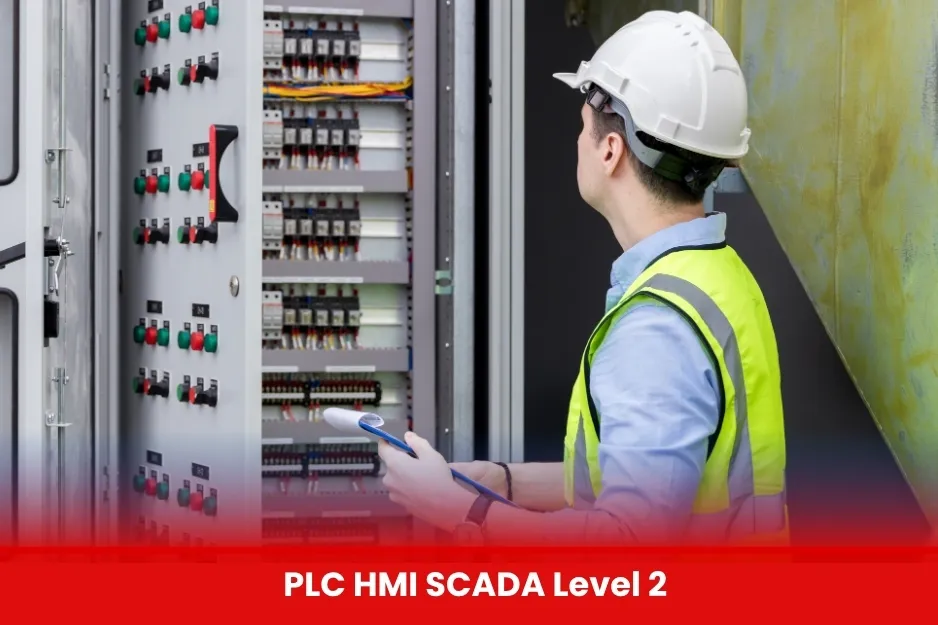PLC HMI SCADA Level 2
The PLC HMI SCADA Level 2 course by BURAAQ provides advanced training in industrial automation. It focuses on programming Siemens PLCs, designing HMI interfaces, and developing SCADA systems for real-time monitoring and control. The course also includes VFD control, MODBUS communication, and data logging, preparing students for automation roles in industries like manufacturing and energy.

Aim of PLC HMI SCADA Level 2
To equip participants with advanced skills in PLC programming, HMI design, and SCADA system development for efficient monitoring, control, and automation of industrial processes.
Course Overview
PLC HMI SCADA Level 2
- Basic knowledge of electrical or electronics engineering
- Completion of PLC Level 1 or equivalent experience
- Diploma, DAE, or degree in Engineering (Electrical, Electronics, Mechatronics, etc.) preferred
| Course Code | Curriculum Title | Credit | DLH |
|---|---|---|---|
| BUK1110-1 | Quick Review of PLC HMI SCADA | 3 | 15 |
| BUK1110-2 | How to make Functions (FC) in TIA Portal | 3 | 15 |
| BUK1110-3 | What is Cross Reference? | 3 | 15 |
| BUK1110-4 | FCS calling in Main (OB) | 3 | 15 |
| BUK1110-5 | Introduction to Factory I/O | 3 | 15 |
| BUK1110-6 | Factory I/O Environment | 3 | 15 |
| BUK1110-7 | FCS calling in Main (OB) | 3 | 15 |
| BUK1110-8 | Motor Control with VFD | 3 | 15 |
| BUK1110-9 | Project Management | 3 | 15 |
| BUK1110-10 | Introduction to EServer | 3 | 15 |
Learning Objectives
- Quick Review of PLC HMI SCADA Level 1 Course.
- Jump and Label instruction in TIA Portal S7 1200/300/400 PLC
- How to make Functions (FC) in TIA Portal
- What is Cross Reference?
- FCS calling in Main (OB)
- Difference between FC and FB
- How to make FB in TIA and How to call it
- Introduction to Factory I/O
- Factory I/O Environment
- Understand industrial automation components on Factory I/O
- Configure and program Factory I/O Applications
- Understand and develop logic on real-time applications
- Create and program your own automation applications
- Understand the uses of sensors, switches, actuators, and conveyors
- Interface & Configure different PLC Programming Software with Factory I/O
- RTUs concept using Provirus
- Motor Control with VFD
- Parameters setting of Analog IO’s in VFD from control terminals
- Connections of Analog IO’s (0-10V or 4-20mA)
- Forward Reverse of Motor using keypad
- The forward reverse of Motor from an external signal
- Controlling the Motor Acceleration and Deceleration time
- Frequency setting range up to 120Hz
- PLC wiring of Analog IO’s with VFD
- Motor Speed control using VFD through PLC Motor Speed control from a thermocouple
- Through temperature.
- Read and Write major parameters of VFD on HMI (winter) via MODBUS RTU using
- RS485
- Two VVFDsMotors Operate with their feedback (McMaster-SlaveVFDs
- Introduction to SCADA
- SCADA system application( Oil GAS / factory /Metro/ Solar Power Plant /Steel Plant )
- System overview TIA Portal,
- WINCC Explorer Professional
- Creating a WINCC Explorer Professional project
- Configuring the connection to the WINCC Explorer automation system
- Structuring the operator interface
- Data & Communications
- Project overview
- Project Management
- Running the Project
- WINCC Explorer SCADA Graphic Designing
- WINCC Explorer SCADA Reporting
- WINCC Explorer SCADA connection with SQL Database by taking value of
- Temperature/pressure/flow/level etc.
- Alarm Logging
- Tag logging & Trend display
- Gauges, sliders, motors, pipes, tanks and other object designing on
- WINCC Explorer SCADA.
- Fundamentals of creating graphics displays for human-machine interfacing
- Navigating through the plant displays
- User administration
- Message representation, message logging, message configuring
- Variable logging, trend configuring and trend plotting
- Trend plotting, and message representation including logging of data in the database
- Graphical Animation
- Web Buttons
- Slider Movement
- Visibility
- More Animations
- Server-side Scripting
- Client-side Scripting
- Many side scripting
- Database
- Recipes
- Introduction to EServer
- SCADA direct Communication with PLC
- SCADA to PLC Communication via EServer
- SCADA to PLC Communication via EServer and Modbus
- Students or graduates of Electrical, Electronics, Mechatronics, or Industrial Engineering
- DAE holders in Electrical/Electronics/Instrumentation
- Technicians and engineers working in automation or maintenance
- Individuals who have completed PLC Level 1 or have basic PLC knowledge
- Professionals looking to upgrade skills in industrial automation, SCADA, or HMI systems
All Modules within this qualification are assessed internally by the approved training Centre and externally verified by BURRAQ UK. The program uses a criterion-referenced assessment approach to ensure that learners successfully meet all required learning outcomes.
A Pass in any unit is granted only when the learner submits valid, reliable, and authentic evidence that demonstrates achievement of the assessment criteria. The Assessor is responsible for reviewing this evidence and confirming that the learner has attained the expected standard.
To guarantee fairness, transparency, and consistency, assessors are required to maintain a detailed audit record, clearly documenting the basis of their assessment decisions in line with quality assurance requirements.
